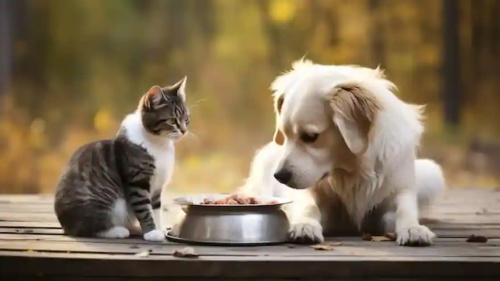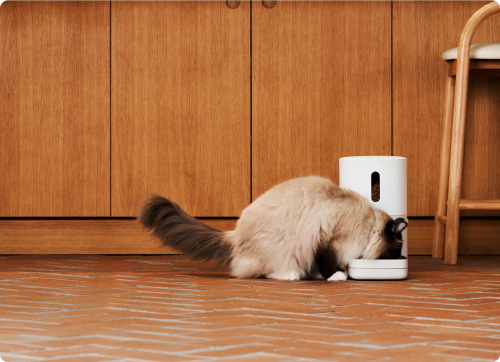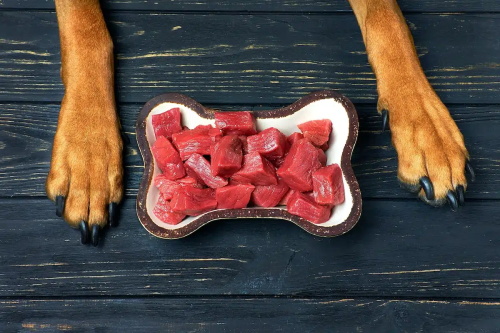Seasonal Feeding Adjustments: How Weather and Temperature Affect Pet Diet

Our pets don't live in a vacuum. Just as humans respond to seasonal changes by adjusting their clothing, activities, and sometimes even their moods, our companion animals—dogs, cats, small mammals, birds, and reptiles—also undergo physiological and behavioral changes in response to changing weather and temperatures. One less obvious, yet crucial, aspect is the dietary adjustments they may need to make.
While many pet owners maintain the same feeding habits year-round, growing evidence and expert opinion suggest that modest but appropriate seasonal adjustments can help maintain optimal body condition, support thermoregulation, and better align nutrition with changing activity, metabolic, and hydration needs.
Why Seasonal Feeding Adjustments Matter?
Metabolic and Hormonal Changes
A pet's metabolism isn't static. Seasonal variations in day length, temperature, and activity levels influence hormonal and metabolic signals. Studies have shown that pets, especially cats, tend to eat more during colder months and naturally reduce their intake during warmer months. Even indoor pets respond to changes in daylight and ambient temperature by subtly adjusting their energy regulation and appetite.
In cold weather, pets typically burn more calories to maintain their body temperature, especially those who spend time outdoors. Conversely, in hot weather, appetite decreases as a natural protective mechanism to avoid generating excessive body heat during digestion. Therefore, maintaining the same feeding habits year-round without adjusting for seasonal changes can lead to minor caloric imbalances.
Fluctuations in Activity and Lifestyle
Energy needs are closely linked to activity levels. In the summer, your pet may be more active outdoors, enjoying hikes, walks, or playtime with you. In the winter, activity levels often decrease due to cold, rainy, or icy weather. For indoor pets, heating and shorter days may further reduce their play and activity levels. This difference can significantly affect their calorie needs.
On the other hand, outdoor pets often expend more energy in the winter simply to stay warm. Understanding whether your pet's environment at different times of the year promotes increased or decreased activity is key to making appropriate feeding adjustments.
Thermoregulation and Energy Utilization
Extreme temperatures force your pet to expend energy to maintain internal balance:
Cold weather: Increased calorie burn to maintain body temperature.
Hot weather: Reduces calorie burn but sometimes suppresses appetite to prevent internal overheating.
Each pet's coat type, size, and body structure determine how much energy they need. Short-haired breeds, small mammals, and some animals that live outdoors often have greater seasonal variations in energy needs than densely-coated or indoor pets.
Hydration and Digestion
Temperature and humidity also affect your pet's hydration. In warmer months, pets lose more water through panting and sweating from their paw pads; in colder months, they typically drink less because they feel less thirsty. Dehydration can put a strain on the digestive system and kidneys. Adding water-rich foods, such as wet food, slightly moistened kibble, or pet-safe broth, can help your pet stay hydrated year-round.
In addition, the digestive process itself generates heat (called the "thermic effect"). In hot climates, this can make your pet feel even hotter, leading to a decreased appetite. Eating smaller, more frequent meals during the summer can minimize this effect.
Seasonal Challenges and Feeding Strategies
Each season brings its own set of challenges that can affect your pet's eating, digestion, and energy expenditure. From the cold of winter to the heat of summer, understanding these seasonal changes can help pet owners adjust their feeding habits to keep their pets healthy and comfortable year-round.
Winter: Beat the Cold with Thermal Support
During colder months, pets, especially those who spend time outdoors, burn more calories to stay warm. Cats and dogs may need a modest increase in food intake, especially those who are thin or active. Foods rich in protein and healthy fats help maintain body temperature and provide the extra energy needed for winter play or walks.
In winter, even if your pet doesn't seem as thirsty, hydration is crucial. Dry air from indoor heating systems can cause mild dehydration. Frequently providing your pet with fresh, unfrozen water or supplementing with water-rich foods, such as wet food or broth, can help maintain fluid balance.
For pets who spend most of their time indoors, calorie needs may remain stable or even decrease slightly due to reduced activity. Overfeeding during the winter is a common mistake and can lead to unwanted weight gain—so closely monitor your pet's condition and adjust feeding amounts accordingly.

Spring: Detoxification and Allergy Awareness
Spring typically means increased activity, increased hair loss, and sometimes allergies. As pets regain their energy, their metabolism speeds up, requiring a gradual adjustment in calorie intake. Transitioning to a lighter, more digestible diet can help with this change.
Seasonal pollen or mold allergies can also affect pets, sometimes causing itchy, watery skin, or indigestion. Anti-inflammatory nutrients, such as omega-3 fatty acids (found in fish oil or flaxseed), can help relieve inflammation and strengthen the skin barrier.
Cleaning feeding areas, bowls, and storage containers is also important in the spring, as warmer weather increases the risk of bacterial growth in leftover or improperly stored pet food.
Summer: Stay Cool and Hydrated
Appetite typically decreases with warmer temperatures. This is the body's natural response to reduce the heat generated during digestion. Feeding lighter meals multiple times a day is easier for your pet to digest than one or two larger meals.
Hydration is paramount. Always provide cool, clean water, and consider adding hydrating supplements like frozen treats made with low-sodium broth or pet-safe fruit purees (for example, watermelon or blueberries for dogs). Wet food can also help increase water intake, especially for cats who may not drink enough.
Avoid high-calorie foods in the summer unless your pet is very active. Overfeeding can cause sluggishness, overheating, or digestive discomfort. It's best to feed your pet during the cooler hours of the day (early morning or late evening) to prevent food spoilage and encourage good eating habits.
Autumn: Preparing for the Seasonal Change
As temperatures drop again, your pet's appetite often naturally increases—a physiological preparation for winter. This is an ideal time to gradually reintroduce higher-calorie foods or slightly larger portions, especially if your pet spends a lot of time outdoors.
Autumn is also the season when many pets shed their fur, so a diet rich in vitamins A and E, biotin, and omega fatty acids can help promote coat renewal and skin health. Digestive support can also be beneficial, as temperature fluctuations and changes in daily routines can sometimes cause minor gastrointestinal discomfort.
If your pet has gained weight during the lazy summer months, the cooler weather of fall is a great way to get back into regular walks, playtime, or agility sessions to help them recover before winter sets in.
Common Pitfalls and Precautions
While adjusting your pet's diet to the changing seasons can greatly benefit their health, it's easy to make mistakes that can do more harm than good. Understanding these common mistakes can help you adjust your diet and avoid unnecessary stress for your furry companion.
1. Overfeeding in Cold Weather
One of the most common mistakes pet owners make is overestimating the number of extra calories their pet actually needs in the winter. While outdoor pets may expend more energy to stay warm, most indoor pets maintain a fairly constant activity level year-round. Adding too much food can quickly lead to weight gain, joint strain, and decreased mobility. It's important to adjust feeding amounts based on your pet's actual activity level, not just the season.
2. Neglecting Hydration During Cold Months
Cold weather often makes both owners and pets less inclined to drink water. However, the combination of indoor heating and dry air can lead to dehydration, dull fur, and even urinary problems—especially in cats. Feeding fresh water multiple times a day or adding moisture-rich wet food to your cat's meals is recommended to promote continuous hydration.
3. Sudden Diet Changes During Seasonal Changes
Pets have very sensitive digestive systems. Sudden changes in food type, portion size, or feeding frequency may cause vomiting, diarrhea, or food refusal. Be sure to transition your pet's diet gradually over 7-10 days, mixing small amounts of the new food with the old until the transition is complete.
4. Over-reliance on Seasonal Treats
Special seasonal treats—like pumpkin treats in the fall or frozen yogurt in the summer—can be fun, but moderation is key. Many commercially available treats are high in calories or contain added sugars and fats. Overindulging your pet can disrupt nutritional balance and increase the risk of obesity or pancreatitis. Consider these treats as occasional rewards, not daily necessities.
5. Misjudging Exercise Needs
Weather changes often alter your pet's activity level. In hot months, they may become lethargic, while cold weather may reduce their outdoor activity. If you don't adjust your diet accordingly, a calorie imbalance can occur. The goal is to match energy intake with energy output—so if your pet is less active, slightly reduce portion sizes; if they're more active, provide extra energy.
6. Neglecting Elderly or Pets with Special Needs
Older pets and those with chronic medical conditions (such as arthritis, diabetes, or thyroid disease) are particularly sensitive to temperature and dietary fluctuations. For example, older dogs may have difficulty regulating their body temperature and require a more easily digestible, nutrient-rich food during colder months. Always consult your veterinarian about any feeding adjustments before changing a medically controlled diet.
Our pets experience the changing seasons just like we do—their nutritional needs change with the weather. By understanding how temperature, humidity, and sunlight affect their pet's metabolism, appetite, and hydration, pet owners can develop a diet that maintains their pet's vitality year-round, rather than relying on a rigid routine.
The key lies in awareness and adaptability. With winter's colder days and shorter days, pets may need richer nutrition and extra calories to stay warm. With the arrival of spring, lighter meals and allergy-friendly supplements can help your pet ease this transition. Summer's heat calls for hydration and cooling foods, while autumn is a time for recovery and preparation for the next cycle.
Seasonal feeding adjustments aren't about following rigid rules; rather, they're about observing your pet's unique reactions and making careful, evidence-based choices. By adjusting feeding habits to align with natural changes, you can maintain balance from the inside out, ensuring your pet thrives despite various climatic challenges.



